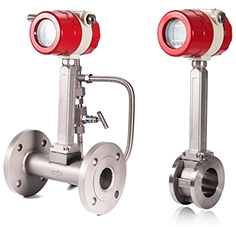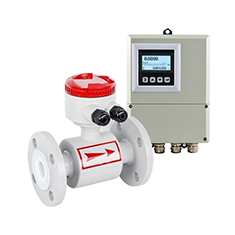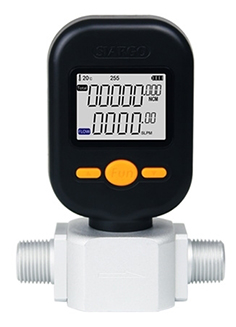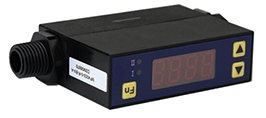What is Flow Meter and Its Types?
A flow meter is a professional automatic measuring instrument. Its main function is to measure the flow of fluids. The measurement medium includes liquid, gas, steam, mixed slurry, solid dust, etc. In the field of industrial automation, flow meters and sensors are called the eyes of the automation system. The result of flow meter measurement is transmitted to the upper computer system, which will integrate and analyze the data and other work, and then apply the preset scheme to the upstream and downstream control systems to play the purpose of intelligent automatic control.
Flow measurement is one of the components of measurement science and technology, and is closely related to national economy, national defense construction and scientific research. Doing this work well plays an important role in ensuring product quality, improving production efficiency, and promoting scientific and technological development. Especially in today's era of energy crisis and increasing automation of industrial production, the status and role of flow meters in the national economy are more obvious. A flow meter is simply an instrument used to measure the flow of fluid in a pipe or open channel. Commonly used flow meters are divided into four categories: Velocity flow meters, volumetric flow meters, rotor flow meters, and mass flow meters.
Velocity flow meter
Velocity flow meter is a type of flow meter, which is characterized by a flow meter that measures the flow rate of the medium directly, and then converts the flow rate into flow rate through calculation. A velocity meter is an impeller installed in a pipe where fluid flows and can rotate freely. When the fluid through the impeller, the kinetic energy of the fluid to make the impeller rotate. The higher the flow rate of the fluid, the greater the kinetic energy, and the higher the impeller speed. In the specified flow range and a certain fluid viscosity, the rotational speed is linearly related to the flow rate.

Therefore, measuring the impeller speed or rpm, you can determine the flow rate or total amount of fluid flowing through the pipe. Common velocity flowmeter are vortex flow meter, turbine flow meter, electromagnetic flow meter, ultrasonic flow meter, etc.
Volumetric flow meter
Volumetric flow meters, also known as fixed-displacement flow meters, or PD flow meters, are the most accurate class of flow meters. Volume flow meters use mechanical measuring elements to continuously divide the fluid into a single known volume part, and measure the total volume of fluid based on the number of times the chamber is repeatedly filled and discharged with that volume part of fluid one at a time.
Volumetric flow meter can be divided into oval gear flowmeter, scraper flowmeter, dual rotor flowmeter, rotary piston flowmeter, reciprocating piston flowmeter, liquid seal rotary flowmeter, wet gas meter and membrane gas flow meter and so on according to its measuring element classification.

Advantages of volumetric flowmeter: high measurement accuracy, installation pipeline conditions have no effect on measurement accuracy, can be used for the measurement of high viscosity liquids, wide range, direct-reading instruments can directly obtain accumulation without external energy, , clear and easy to operate .
Disadvantages of volumetric flowmeter: complex structure makes the weight larger and higher cost, not suitable for foreign objects and low viscosity liquid (above 1CP), the bearings are easy to wear and require regular inspection, the installation is complicated and laborious, and in the medium and large diameter of the flowmeter is less competitive.
Rotor flow meter
The rotor flow meter measures the fluid flow according to the throttling principle, but it changes the flow area of the fluid to keep the differential pressure above and below the rotor constant, so it is also called a variable flow area constant differential pressure flowmeter, also known as a float flowmeter. Rotameters are the most commonly used flowmeters in industry and laboratories. It has the characteristics of simple structure, intuitive, small pressure loss, easy maintenance and so on.
Relying on the advantages of small pressure loss and large detection range, the rotameter has become a very commonly used flow measurement instrument in industrial control. It is not only easy to use, but also has the advantages of strong compatibility. It is especially suitable for medium flow measurement with low flow rate and small flow. Over the years, the various excellent performance and reliability of the rotor flowmeter, as well as the better performance-price ratio, have been widely favored by petrochemical, steel, electric power, metallurgy, light industry and other industries.

Mass flow meter
The volume of the fluid is a function of fluid temperature and pressure, is a dependent variable, while the mass of the fluid is a quantity that does not change with time, space temperature and pressure. Commonly used flowmeter, such as orifice plate flowmeter, laminar flow mass flowmeter, turbine flow meter, vortex flow meter, electromagnetic flow meter, rotameter, ultrasonic flowmeter and oval gear flowmeter flow measurement value is the volume flow of fluid. In scientific research, production process control, quality management, economic accounting and trade handover and other activities involved in the amount of fluid is generally more mass. Using the above-mentioned flowmeter only to measure the volume flow of fluid often does not meet the requirements of people, usually also need to try to obtain the mass flow of fluid. Previously, only after measuring the fluid temperature, pressure, density and volume and other parameters, through correction, conversion and compensation methods to indirectly obtain the mass of the fluid. This measurement method, many intermediate links, the accuracy of mass flow measurement is difficult to ensure and improve. With the development of modern science and technology, a number of direct measurement of mass flow measurement methods and devices have emerged one after another, thus promoting the progress of flow measurement technology, the emergence of mass flow meters.
The mass flow meter directly measures the mass flow of the medium passing through the flowmeter, and can also measure the density of the medium and indirectly measure the temperature of the medium. Since the transmitter is an intelligent instrument with a single-chip microcomputer as the core, more than a dozen parameters can be derived for users to use according to the above three basic quantities. The mass flow meter is flexible in configuration, powerful in function and high in cost performance. It is a new generation of flow meter.
The flowmeter can be divided into: Liquid flowmeter and gas flowmeter according to the medium of the measured substance. Common measuring liquid and gas flow meters can be divided into:
- Flow meter for measuring clean liquids: Electromagnetic flow meters, ultrasonic flow meters, vortex flow meters, turbine flow meters, etc.
- Flow meter for measuring gas: Vortex flow meter, orifice flow meter, balance flow meter, gas mass flow meter, etc.
- Flow meter for measuring steam: Orifice flow meter, vortex flow meter, elbow flow meter, etc.
- Flow meter for measuring slurry: Magnetic flow meter.
Users should choose the right flowmeter according to the needs of the application. Choosing the wrong flowmeter will not only affect the project,but also cause unnecessary lossesto the control system.


